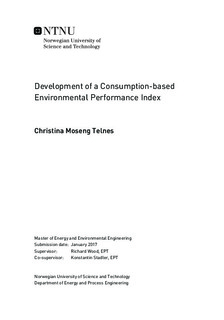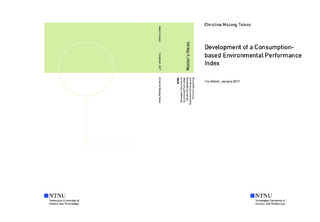| dc.description.abstract | Exceeding pressure is put on the Earth s ecosystems through increased consumption and human activities. Maintaining a sustainable level of resource use and keeping environmental impacts within acceptable limits is one of the greatest challenges of today. Several efforts have been made to quantify sustainability (e.g. the United Nations Millennium Goals (MDGs)) and measure environmental impacts. Setting specific targets for sustainability is an important part of promoting sustainable policy making. However, the traditional method used for these quantifications are based on a territorial (production-based) accounting (PBA) scheme, and impacts embodied in trade are not accounted for. An alternative accounting scheme using consumption-based accounts (CBA), or footprinting, can be applied to correct this problem through the use of Environmentally Extended multiregional input-output (EE MRIO) analysis.
This thesis combines the production-based 2014 Environmental Performance Index (EPI) with the EE-MRIO database EXIOBASE v3 to create an alternative consumption-based index. By incorporating CBA data into the EPI index an improved tool for sustainable decision-making may be achieved. The alternative index s applicability in sustainability assessment is evaluated by comparing the original EPI and the alternative index. First the reproducibility of the EPI is examined. The two aforementioned indices are then investigated in detail for the year 2011 and furthermore a timeline comparison is conducted between 2002 and 2011 using China, Norway and the United States as example countries.
The EPI showed an appropriate level of reproducibility, both for the score values and for the weightings. Despite less reproducibility between data sources and raw data, the index methodology was deemed fit for further modification. For 2011, the results show significant methodological difference between the EPI and the alternative index compared to the differences from using different accounting schemes. The timeline results for three countries show trends in correspondence with the expectations for the relationship between production and consumption based accounting schemes from other research. However, the alternative indicators only amount to 37 % of the total index resulting in lowered influence on the final index. The alternative CO2 Intensity indicator was compared to the greenhouse gas (GHG) impact results of the EXIOBASE v3 for the three countries over time. Points of similarity were found, but Norway stood out with a noticeably different curve likely caused by its net export of materials embodied in trade. Signs of absolute decoupling were detectible for all three countries.
The alternative index is suffering from the methodological differences observed, but still shows promising signs of accurately depicting the effects of switching accounting schemes (PBA to CBA). Improvements to the weightings and targets are necessary for the alternative index to provide a good alternative to the current EPI. If these adjustments are achieved however, such a consumption-based index could provide policymakers with an improved tool for decision-making, and thus contributing to a sustainable future with continued decoupling of environmental impacts from the economic development.
It is recommended to continue the development of the alternative index with a focus on targets and weightings in order to provide a robust consumption-based index that can be considered as a realistic alternative to the EPI. | |

